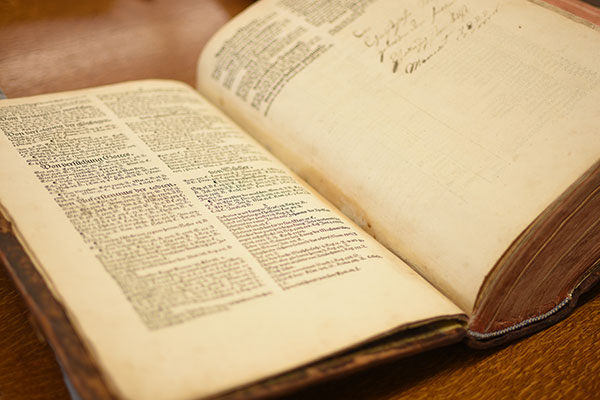Rare Bible conserved
03/18/2022

An Ohio Library Services and Technology Act Preservation Grant funded the conservation treatment of Bluffton’s 1531 Froschauer Bible.
16th century German-language Bible accessible for careful study
As director of Musselman Library, Carrie Phillips ’99 believes even the “rarest collections are meant to be studied.”
However, the oldest Bible in Bluffton University’s Musselman Library, dating to the 16th century, was nearly relegated to restricted status in the archives to prevent further wear, tear and damage.
Instead, Phillips applied for and was awarded nearly $5,000 for an Ohio LSTA (Library Services and Technology Act) Preservation Grant for a conservation treatment of Bluffton’s 1531 Froschauer Bible.
“Sometimes damage can perpetuate itself,” explained Phillips. “Through this grant, we focused on the work that would make the Bible the most stable.”
Jeff Peachey, a Goshen College graduate and book conservator in New York City, completed the work. The primary goal was restoring the structural integrity of the Bible so the volume could be handled and examined—with proper handling techniques and a supportive cradle—without further damage to the binding or text block. In addition, the entire book’s surface was cleaned, tears and losses were repaired, and previous “repairs” were removed to reduce damage from the stiff adhesive. The book’s hinges were also repaired, and both the sewing and spine were reinforced.
Now, library visitors and students completing research have access to the Bible once again.
“As long as we’re taking proper care of and looking at these artifacts carefully, there’s no reason our students shouldn’t handle something from the 16th century and appreciate it,” said Phillips, who has organized Bible Petting Zoos for students. “They get so excited. It’s a connection to the past, and they might discover unique additions such as handwritten margin notes or a family tree on a flyleaf.”
Bluffton’s Froschauer Bible is significant for a number of reasons. It’s an example of the first folio edition of a German-language Bible, and it’s one of only 12 known surviving copies of this edition. Folio refers to all of the books of the Bible being published in one volume. The translation is German, and much of the phrasing would have been familiar to Swiss Mennonites.
“We often think about Martin Luther translating the Bible into German so the everyday person could read it. This Bible does incorporate some of Martin Luther’s work, but other parts were translated by other Biblical scholars, some of them Anabaptist. 1531 is the first time a complete German-translated Bible was printed in one volume,” explained Phillips. “That precedes Martin Luther’s complete Bible by three years.”
The preservation process took longer than anticipated. The Bible was shipped to Peachy Conservation in December 2019. However, when COVID-19 infections began to climb in spring 2020, Peachey’s family relocated to upstate New York while the Froschauer Bible remained at Peachey’s residence in the city. The preservation process was completed just in time to meet the grant’s parameters.
Julia Szabo, development associate at Bluffton, collected the Bible while visiting donors in November 2021 and safely transported it back to the archives.
Not much is known about the provenance of the Bible. It was donated to Bluffton in 1982 by the Earl Fox (Fuch) family of Kansas. A note explained the Bible came from Earl’s father, Amos, via his grandparents, Jacob and Rachel (Mosier) Fox of Sterling, Kan.
“Bluffton’s archives and special collections are a connection to our Mennonite and Anabaptist roots,” said Phillips. “This Bible is part of the Mennonite Historical Collections, along with other rare books and manuscript collections, all which connect the university to important people and events in Mennonite history.”